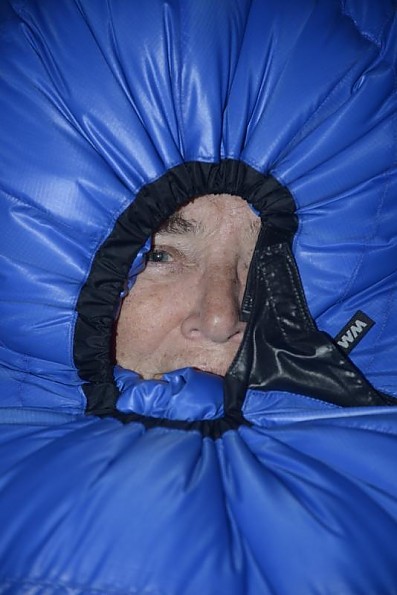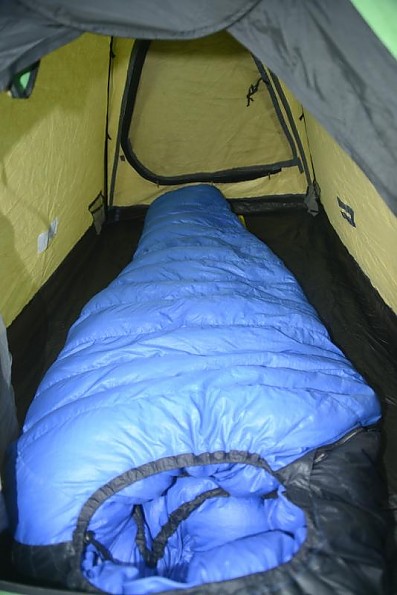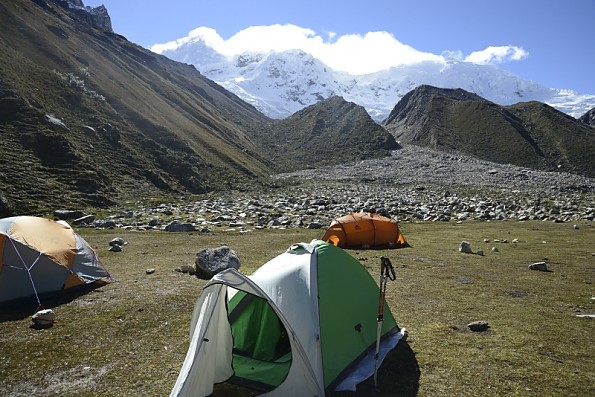Western Mountaineering Antelope MF

One of the highest quality sleeping bags available. Three-season bag that can be used well into early fall or from early spring. Very versatile bag and well worth the price.
Pros
- Very high quality
- Microfiber shell breathes well while still shedding spilled drinks
- Includes breathable storage bag that leaves bag uncompressed
- Easily meets the specified temperature range (5°F/-15°C)
- Lightweight for temperature rating
- Stuffs small if you get a compression stuff sack
Cons
- Price is high (as with any high quality product)
- Down can get soaked if you neglect precautions
- Included stuff sack does not compress bag very small
Introductory comment: This review is different from most of my reviews, in that it is not a review assigned in my capacity as one of the Trailspace Gear Review Corps. Nonetheless, I have included my usual description of the criteria I demand of the product, how I used it, and ways I have found to get the best out of the product. I did not do any planned tests, but just used the sleeping bag on my normal excursions into the woods and hills.
Background: One of the most critical items for the backpacker, climber, backcountry skier, or snowshoer is the sleeping bag. A good sleeping bag can mean the difference between a good night’s restful sleep and misery. Among the criteria are warmth to match the environment, weight of the bag in your pack, comfort to match your size, durability, and a reasonable cost for what you get.
Barb and I have more than 10 sleeping bags that we have acquired over the years, ranging from “summer only” to bags intended for expedition use in arctic regions in winter. Some are synthetic fill, and most are down (none of the “treated” down bags, though, which are claimed to be highly water-resistant). Most have microfiber outer shells, with two having waterproof shells. We have used our bags in Death Valley in summer and in Alaska, Antarctica, and up to high camp on Denali, camping on all 7 continents .
Most of the sleeping bags we own are from Big Name manufacturers, a couple of which are subsidiaries of large conglomerates. The exceptions are (now) our Feathered Friends and Western Mountaineering bags, which are more like “craft” shops, albeit much more professional and much higher quality than the usual craft manufacturer.
After my first couple of trips with the American Climber Science Program to the Cordillera Blanca, I realized while I had summer (above 35°F/0°C) and 3-season bags (late-spring and early fall) plus polar-rated and high altitude bags, I did not have a bag that fit the in-between seasons that I was encountering in the Andes. Well, I had a couple bags that supposedly were good to 0°F, but had proved to be marginal (they were by big-name manufacturers). The EN rating standard is used by most European manufacturers, though frequently not by US companies. Barb and I have -40°F/C bags from Feathered Friends, which have proven to meet their ratings in an Alaska dogsledding trip , as well as on Denali and in Antarctica. However, my FF bag proved too warm in the Andes, prompting the search for a transition season bag.
Friends had recommended looking at Western Mountaineering bags. I knew from my friends that WM’s reputation was high (as are their prices, which is true for FF as well). During a couple of trips to Salt Lake City for the Outdoor Retailer Show and skiing at Alta, I had looked at the WM bags, both at the IME shop in SLC and at the display in the OR Show. I was very impressed at the quality.
WM also happens to be based where I live in the San Francisco Bay Area. So I bought the Antelope microfiber bag in 2012. I visited the WM shop to pick up the bag (saving shipping costs) and was thoroughly impressed by their attention to detail. I had done a similar tour of FF at their facility in Seattle (just a couple blocks from the REI Flagship Store).
Barb decided that she needed an Antelope as well, and demanded that the two bags should zip together. So last month, I bought hers, with the zippers mating to make a double bag. Most of my findings apply to both my 4-year old bag and her brand new one. The only real differences are the length and that hers is “overfilled”. Well, and also in the past several years, prices have gone up.
During most of the last half of 2015, the West Coast has been hit by major strikes at all West Coast ports. This resulted in a shortage of down (most of which in the US is imported from Asia), which drove the prices of down gear up substantially (roughly doubling the store prices). In addition, when an agreement was reached, the cost of delivering a container with down from the Oakland port to the Western Mountaineering facility in San Jose went from roughly $300 to $1000, according to the owner of WM. As a result of the big jump in down prices and shipping, we paid much more for her bag.
My expectations in a sleeping bag are:
- Warmth to suit the season (this requires multiple bags)
- Good breathability (to avoid moisture buildup in the fill over the duration of a trip)
- Light weight (compatible with my required warmth)
- Plenty of room, but not too much (for winter bags, where I will bring my boot liners inside to keep them warm, but not so much as to lose heat)
- Ease of entry and exit
- Ease of use of hood and collar adjustments
- Zippers work smoothly and do not grab on the cloth
- Baffles, collars, and hood adequately block cold air flow.
- Small liquid spills do not immediately penetrate or wet-out the shell
First Impressions: When I unpacked the Antelope from its storage bag, I checked its features against my expectation list. The loft was immediately apparent with a little shaking (the included storage bag allows the bag to be minimally compressed — if you have the room available to hang the bag, it is better to do so — but with our large collection of backpacking, skiing, and climbing gear, space is at a premium in our house).
Measured loft was 8 inches (that is “double layer” – when in the bag, the bottom half is compressed, so 4 inches of down on top is providing the insulation). Western Mountaineering gives a 5°F rating to the Antelope. Backpacking Light gives an estimate of -20°F/-29°C for 4 inches/10 cm of loft on top. But keep in mind that how warm you are, is a combination of the insulation of the pad under you, how tired you are, how recently you ate, what you ate, whether you are sheltered in your tent or outside with no wind break, and the clothing you wear into the bag.
I prefer to use WM’s more conservative estimate, especially when I consider how tired and chilled I am after 8 hours of climbing a couple thousand feet in a white-out blizzard, followed by pitching the tent. I measured a weight of 2lb10oz/1208gm (WM website lists 2lb7oz/1105gm).
The quality and attention to detail is immediately apparent in such things as the straight stitching (I have a couple bags from Big Name manufacturers that have more than a few wiggles). In many of my down bags, you get a few plumules of down poking through after a while, especially after stuffing and compressing, then unpacking the bag a few times. During the life of my Antelope, there have been only one or two plumules that have appeared, all of which I have managed to pull back into the bag.
Baffle spacing is 5.25 inches. The down fill power is measured by an independent laboratory to be 850+. Over time and usage, the true fill power will decrease due to stuffing the bag into a compression sack (so it will fit inside your pack) and the accumulation of body oils. Proper washing with one of the down washes from Nikwax or McNett will restore most of the loft. Use only an industrial front-load washer or wash by hand in a bathtub (I have found the large industrial washers to do a better job than hand-washing). But store your sleeping bag either by hanging in a closet or in the supplied large storage sack that Western Mountaineering includes.
The full-length 2-way zipper is bounded by a section of stiff material, which prevents the catching of the liner material – one of the best setups I have seen in a sleeping bag. The zipper is backed by a full length baffle, which hangs down from above the zipper as it should. This ensures that the outside cold air is blocked, while the air warmed by your body is kept inside the bag.
I have a bag from another manufacturer (a famous, big-name company), where the baffle comes up from underneath. This allows the baffle to flop down, allowing cool air from outside to penetrate. The full-length 2-way zipper allows opening from the bottom to allow extra ventilation if conditions prove to be too warm. I noted that, unlike another sleeping bag I reviewed for Trailspace, both zipper slides have pulls on the inside as well as the outside, making it easy to operate in a 1-person tent or when the tent is fully occupied to capacity.
The collar wraps fully around the neck, with plenty of “puff”, which effectively restricts warm air from the body part of the bag from escaping. There is a drawcord to adjust the air flow in case of warmer weather. The hood also has a draw cord and plenty of fill. I found that I could close the hood to the point that only my nose was exposed. This allows you to get plenty of air while not breathing your moist breath into the down fill (which will freeze in the fill, adding weight to the bag). The photo below is Barb in her new Antelope.

The Antelope is blue on the upper part of the bag, with a black bottom that would face your sleeping pad. The inside of the bag is fully black (Barb’s new Antelope is blue for the full exterior, still with a fully black interior). This facilitates drying the bag when it accumulates condensation of your overnight perspiration (usually estimated as 1 to 2 liters overnight). You can fully unzip the bag and turn it inside out, then drape it on top of your tent to dry in the sun (on a sunny day).
I mentioned that the microfiber shell breathes well, while still shedding minor spills. A practice I learned many years ago is, when first arising, tightly roll your sleeping bag to force much of the water vapor out of the fill. Then fluff up the bag to draw in drier air and repeat the rolling. If you neglect to do this, moisture will accumulate and freeze, adding weight to the bag. The polar explorer, Will Steger, discovered this the hard way on one of his early polar expeditions. By the time they reached the pole, the group’s sleeping bags had accumulated something like 70 pounds of frozen moisture.
Details: I have now had my Antelope for almost 4 years, using it for extended periods in the Cordillera Blanca and for winter backcountry tours in the Sierra. Since the bag was not assigned for a formal review, I did not keep a formal count of the number of nights usage, the temperatures, and other conditions.
The table found here on the WM website gives the sizing information. My measured shoulder girth is 42 inches, comfortably within the listed 62 inch shoulder girth. For me, the 6 foot Antelope is a very comfortable fit. For my current height of 5ft 8in (us Old Greybeards tend to shrink a bit as we add more years), the bag length leaves enough space at the foot to keep my boot liners in the foot of the bag to keep them warm enough to not struggle to get my boots on in the morning.
This video demonstrates several of the important features.
The photo below is the view of the interior of the the Black Diamond Bibler Eldorado that I use on many of my trips (such as my expeditions with the American Climber Science Program) with the Antelope inside.
As noted above, Barb decided she needed an Antelope as well, since we do a lot of hiking during the transition seasons and at high altitudes in the Sierra, Rockies, and elsewhere in the world. We got my Antelope with the zipper on the left side. Since the Antelope zippers can be mated to make a 2-person bag, when we bought Barb’s, we got it with a right-side zipper, as shown in the photo at left (this time in our Mountain Hardwear Trango 3.1 expedition tent).
The photo shows my older and Barb’s new Antelope, zipped together. One minor problem is that if one person has to make a relief trip during the night, the exit zipper is in the middle between the two bags. Since my bag is the 6 foot and Barb’s is the 5 foot 6 inch version, the zippers are mismatched for a short 5 inch section. This is only a cosmetic problem, not an operational one.
The photo below is from my 2013 expedition to Peru, taken on June 11, 2013. The location is the Ishinca Valley. The tent in the foreground is my Bibler Eldorado. If you were to magnify the image a lot and do some color correction, you could see the Antelope inside the tent.
We were camped here for about two weeks, during which we climbed several peaks and gathered samples of the soil, water, air, and ice and snow from the glaciers. As was typical of all our excursions in the Andes, we had temperatures to below freezing, rain, and occasional snow. As you would expect from the latitude of about 9°South, daytime temperatures could get into the 50°F range.
Typically, we spend one to two weeks in the field, then return to a hostal in town for a few days of review and planning, then return to the field (usually a different part of the Cordillera Blanca) for another one or two weeks of field work. As typical of hostals everywhere, you sleep in your sleeping bag (although the bag is rather warm for in-town use). This adds up to a month or more of use of the bag each research season.
This photo is in the Quilcayhuanca Valley, with my Eldorado in the foreground. July 9, 2014. This marked a return to Quilcayhuanca part of the Cordillera Blanca to revisit sampling sites for longitudinal study, including snow and ice samples from a couple of glaciers not previously visited. I spent a bit over two weeks camped here for a total of three weeks in the Antelope on this trip.
Among other outings where I used the Antelope were the Winter Camping training courses for adult Boy Scout leaders, where I am one of the instructors. Each of these courses includes three days camping in snow (often with a bit of snowfall, and sometimes with a lot of snow).
I used it for two sessions of the High Adventure Training course for adult Boy Scout leaders, though the weather for that was somewhat warmer. Also, I used the Antelope on a climb of Mt. Shasta and on South Sister and Mt. Hood in the Cascades.
Conclusions: In my use over the past almost four years, the Western Mountaineering Antelope has proven to meet my expectations for a transition season sleeping bag. I have used (and abused) it in warmer and colder weather than it was designed for. Of all the bags we have acquired and used, it is one of the highest quality and best performers of any of the bags I use for my outings and expeditions (the other being my Feathered Friends bag). I expect Barb’s bag to perform as well.
Source: bought it new
Your Review
Where to Buy
You May Like
Specs
| short | regular | long | ||
|---|---|---|---|---|
| Price |
Current Retail: $690.00-$805.00 Historic Range: $360.00-$805.00 |
|||
| Weight | 2 lb 5 oz / 1050 g | 2 lb 7 oz / 1105 g | 2 lb 9 oz / 1160 g | |
| Fill weight | 1 lb 8 oz / 680 g | 1 lb 10 oz / 735 g | 1 lb 12 oz / 790 g | |
| Loft | 7 in / 18 cm | 7 in / 18 cm | 7 in / 18 cm | |
| Temperature rating | 5 F / -15 C | 5 F / -15 C | 5 F / -15 C | |
| Fill | 850 fill-power down | 850 fill-power down | 850 fill-power down | |
| Shape | Mummy | Mummy | Mummy | |
| Max user height | 5 ft 6 in / 165 cm | 6 ft 0 in / 180 cm | 6 ft 6 in / 200 cm | |
| Shoulder girth | 62 in / 157 cm | 62 in / 157 cm | 63 in / 160 cm | |
| Hip girth | 53 in / 135 cm | 53 in / 135 cm | 54 in / 137 cm | |
| Foot girth | 39 in / 99 cm | 39 in / 99 cm | 39 in / 99 cm | |








